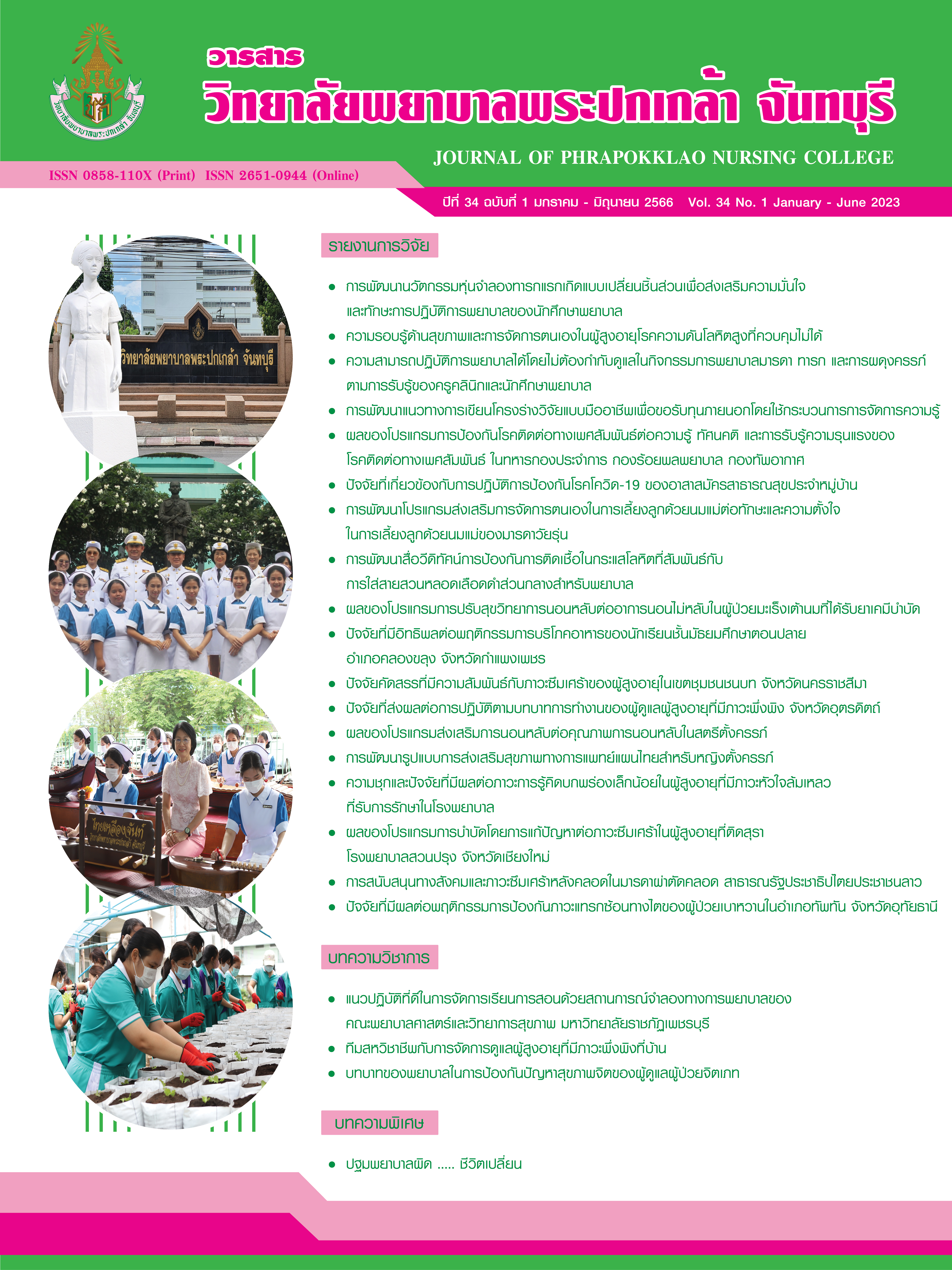Good Practice in Teaching and Learning Methods Using the Nursing Simulation, Faculty of Nursing and Allied Health Sciences, Phetchaburi Rajabhat University
Keywords:
Good practice, Teaching and learning methods, Nursing simulationAbstract
Simulation is considered an advanced technology in health artificial intelligence, widely used in nursing education, nowadays. It greatly enhances the integration of theoretical knowledge with practical application, fostering increased confidence, decision-making abilities, and critical thinking skills among nursing students. Recognizing the importance of blended learning, the Faculty of Nursing and Allied Health Sciences at Phetchaburi Rajabhat University developed a good practice in teaching and learning methods using the nursing simulation. Simulation provides learners with opportunities to practice nursing skills in an environment closely resembling real-world situations. The development process begins with setting learning objectives, creating instructional guides for simulation-based learning, identifying necessary materials and equipment for each subject, developing plans/manuals, creating a practice guide, and evaluating outcomes. Moreover, there is an exchange of knowledge between nursing instructors and nurses in practical training settings to develop highly realistic simulations. This practice guide recommends the following to enhance the systematic administration of teaching and learning, to foster learners' competencies to achieve desired learning outcomes as defined by the curriculum: 1) aligning the design of simulation with the nursing process framework; 2) planning the development of simulation for all subjects to comply with the competency levels of each year; and 3) designing a systematic evaluation for the use of simulation.
References
บรรณสรณ์ เตชะจำเริญสุข. (2564). การพัฒนาคุณภาพด้วย FOCUS-PDCA. สืบค้นจาก https://www.researchgate.net/publication/352519279_Review_article_karphathnakhunphaphdwy_FOCUS-PDCA_bthkhwamsuksatxneuxngthangphesachsastr
มูลนิธิสถาบันวิจัยและพัฒนาผู้สูงอายุไทย. (2562). สถานการณ์ผู้สูงอายุไทย พ.ศ. 2561. นครปฐม: พริ้นเทอรี่.
ระพีพัฒน์ หาญโสภา, พระมหาศุภชัย ศุภกิจโจ, ประยุทธ ชูสอน, สุทธิพงษ์ สนสุวรรณ, และมณฑกานต์ บุ่งเสน่ห์. (2563). การจัดการเรียนรู้ในศตวรรษที่ 21: ทฤษฎีสู่การปฏิบัติ. วารสารวิชาการธรรมทรรศน์, 20(2), 163–172.
วรรณภา ใหญ่มาก, ภัทร์ฐิตา สุภาโสต, และเอกชัย นาคถนอม. (2561). การมีส่วนร่วมในการปฏิบัติงานด้านการประกันคุณภาพการศึกษาภายในด้วยวงจรคุณภาพ PDCA ของบุคลากรมหาวิทยาลัยเทคโนโลยีราชมงคลสุวรรณภูมิ (รายงานผลการวิจัย). พระนครศรีอยุธยา: คณะศิลปศาสตร์ มหาวิทยาลัยเทคโนโลยีราชมงคลสุวรรณภูมิ.
วรัฎฐา เหมทอง, และวีรยุทธ ศรีทุมสุข. (2563). ผลของการใช้ภาพเคลื่อนไหวสามมิติต่อผลสัมฤทธิ์ทางการเรียนวิชากายวิภาคศาสตร์ระบบหัวใจของนักศึกษาวิทยาศาสตร์สุขภาพ. วารสารมหาวิทยาลัยคริสเตียน, 26(1), 94–103.
วันดี แก้วแสงอ่อน, อุทุมพร ดุลยเกษม, และสุทัศน์ เหมทานนท์. (2564). การจัดการเรียนการสอนทางการพยาบาลด้วยสถานการณ์จำลองเสมือนจริง: จากห้องเรียนสู่การเรียนรู้ด้วยโปรแกรมออนไลน์. วารสารมหาจุฬานาครทรรศน์, 8(11), 96–111.
ศุภรัตน์ แจ่มแจ้ง, วิรดา อรรถเมธากุล, รัตนา นิลเลื่อม, และนาตยา วงศ์ยะรา. (2564). ผลของการเรียนรู้โดยใช้สถานการณ์จําลองเสมือนจริงต่อความสามารถในการแก้ปัญหาทางการพยาบาลและความมั่นใจในการปฏิบัติการพยาบาลผู้ป่วยที่มีปัญหาสุขภาพของนักศึกษาพยาบาล. วารสารวิทยาลัยพยาบาลพระจอมเกล้า จังหวัดเพชรบุรี, 4(3), 178–194.
สมจิตต์ สินธุชัย, และกันยารัตน์ อุบลวรรณ. (2560). การเรียนรู้โดยใช้สถานการณ์จำลองเสมือนจริง: การนำไปใช้ในการจัดการเรียนการสอน. วารสารพยาบาลทหารบก, 18(1), 29–38.
อติญาณ์ ศรเกษตริน, ดาราวรรณ รองเมือง, และรุ่งนภา จันทรา. (2562). การศึกษาพยาบาลในศตวรรษที่ 21: สมรรถนะและบทบาทของอาจารย์พยาบาล. วารสารพยาบาลทหารบก, 20(1), 12–20.
Foronda, C. L., Alfes, C. M., Dev, P., Kleinheksel, A. J., Nelson, D. A., O’Donnell, J. M., & Samosky, J. T. (2017). Virtually nursing: Emerging technologies in nursing education. Nurse Educator, 42(1), 14–17. doi:10.1097/NNE.0000000000000295
Kaldheim, H. K. A., Bergland, Å., Ølnes, M. A., Hofsø, K., Dihle, A., Creutzfeldt, J., ... Steindal, S. A. (2019). Use of simulation-based learning among perioperative nurses and students: A scoping review. Nurse Education Today, 73, 31–37. doi:10.1016/j.nedt.2018.09.013
Manninen, K., Henriksson, E. W., Scheja, M., & Silén, C. (2015). Supervisors’ pedagogical role at a clinical education ward – an ethnographic study. BMC Nursing, 14, 55. doi:10.1186/s12912-015-0106-6
Regional Office for Europe, World Health Organization. (2018). Simulation in nursing and midwifery education. Copenhagen, Denmark: WHO Regional Office for Europe. Retrieved from https://apps.who.int/iris/bitstream/handle/10665/345156/WHO-EURO-2018-3296-43055-60253-eng.pdf?sequence=2&isAllowed=y
Sessums, C. D. (2016). What is OBE?: Unboxing outcomes-based education. Retrieved from https://www.d2l.com/blog/what-is-obe/
Downloads
Published
How to Cite
Issue
Section
Categories
License
Copyright (c) 2023 JOURNAL OF PHRAPOKKLAO NURSING COLLEGE

This work is licensed under a Creative Commons Attribution-NonCommercial-NoDerivatives 4.0 International License.
เนื้อความ ข้อมูล และรายการอ้างอิงที่ผู้เขียนใช้ในการเขียนบทความเพื่อลงตีพิมพ์ในวารสารวิทยาลัยพยาบาลพระปกเกล้า จันทบุรี ถือเป็นความคิดเห็นและความรับผิดชอบของผู้เขียน คณะผู้จัดทำวารสารไม่จำเป็นต้องเห็นพ้องด้วยหรือร่วมรับผิดชอบ
บทความที่ได้รับการลงตีพิมพ์ในวารสารวิทยาลัยพยาบาลพระปกเกล้า จันทบุรี ถือเป็นลิขสิทธิ์ของวารสารวิทยาลัยพยาบาลพระปกเกล้า จันทบุรี หากหน่วยงานหรือบุคคลใดต้องการนำส่วนหนึ่งหรือทั้งหมดของบทความไปเผยแพร่ต่อเพื่อวัตถุประสงค์ใด ๆ จะต้องได้รับอนุญาตจากบรรณาธิการวารสารก่อน



